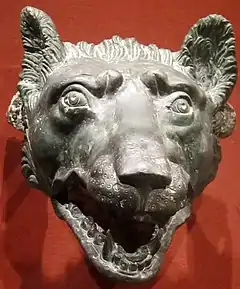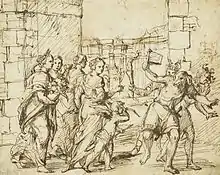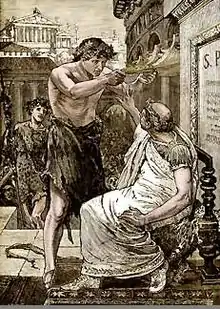Lupercalia
Lupercalia was an ancient, possibly pre-Roman pastoral annual festival,[2] observed in the city of Rome from the 13th to the 15th of February to avert evil spirits and purify the city, releasing health and fertility. Lupercalia was also called dies Februatus, after the instruments of purification called februa, which gave February (Februarius) its name.
| Lupercalia | |
|---|---|
 Lupercalia most likely derives from lupus, "wolf", though both the etymology and its significance are obscure[1] (bronze wolf's head, 1st century AD) | |
| Observed by | Roman Kingdom, Roman Republic, Roman Empire |
| Type | Classical Roman religion |
| Celebrations | feasting |
| Observances | sacrifices of goats and a dog by the Luperci; offering of cakes by the Vestals; fertility rite in which the goatskin-clad Luperci strike women who wish to conceive |
| Date | February 13, February 14, February 15 |
Name
The festival was later known as Februa ("Purifications" or "Purgings") after the februum which was used on the day.[3] It was also known as Februatus and gave its name to Juno Februalis, Februlis, or Februata in her role as its patron deity; to a god called Februus, and to February (mensis Februarius), the month during which it occurred.[3] Ovid connects februare to an Etruscan word for "purging".[4] Some sources connect the Latin word for fever (febris) with the same idea of purification or purging, due to the sweating commonly seen in association with fevers.
The name Lupercalia was believed in antiquity to evince some connection with the Ancient Greek festival of the Arcadian Lykaia, a wolf festival (Greek: λύκος, lýkos; Latin: lupus), and the worship of Lycaean Pan, assumed to be a Greek equivalent to Faunus, as instituted by Evander.[5] Justin describes a cult image of "the Lycaean god, whom the Greeks call Pan and the Romans Lupercus", as nude, save for a goatskin girdle.[6] It stood in the Lupercal, the cave where tradition held that Romulus and Remus were suckled by the she-wolf (Lupa). The cave lay at the foot of the Palatine Hill, on which Romulus was thought to have founded Rome.[7]
Rites
Locations
The rites were confined to the Lupercal cave, the Palatine Hill, and the Forum, all of which were central locations in Rome's foundation myth.[8] Near the cave stood a sanctuary of Rumina, goddess of breastfeeding; and the wild fig-tree (Ficus Ruminalis) to which Romulus and Remus were brought by the divine intervention of the river-god Tiberinus; some Roman sources name the wild fig tree caprificus, literally "goat fig". Like the cultivated fig, its fruit is pendulous, and the tree exudes a milky sap if cut, which makes it a good candidate for a cult of breastfeeding.[9]
Priesthoods
The Lupercalia had its own priesthood, the Luperci ("brothers of the wolf"), whose institution and rites were attributed either to the Arcadian culture-hero Evander, or to Romulus and Remus, erstwhile shepherds who had each established a group of followers. The Luperci were young men (iuvenes), usually between the ages of 20 and 40. They formed two religious collegia (associations) based on ancestry; the Quinctiliani (named after the gens Quinctia) and the Fabiani (named after the gens Fabia). Each college was headed by a magister. In 44 BC, a third college, the Juliani, was instituted in honor of Julius Caesar; its first magister was Mark Antony.[10] The college of Juliani disbanded or lapsed following Caesar's assassination, and was not re-established in the reforms of his successor, Augustus. In the Imperial era, membership of the two traditional collegia was opened to iuvenes of equestrian status.
Sacrifice
At the Lupercal altar, a male goat (or goats) and a dog were sacrificed by one or another of the Luperci, under the supervision of the Flamen dialis, Jupiter's chief priest.[11] An offering was also made of salted mealcakes, prepared by the Vestal Virgins.[12] After the blood sacrifice, two Luperci approached the altar. Their foreheads were anointed with blood from the sacrificial knife, then wiped clean with wool soaked in milk, after which they were expected to smile and/or laugh.
The sacrificial feast followed, after which the Luperci cut thongs (known as februa) from the flayed skin of the animal,[2] and ran with these, naked or near-naked, along the old Palatine boundary, in an anticlockwise direction around the hill.[13] In Plutarch's description of the Lupercalia, written during the early Empire,
...many of the noble youths and of the magistrates run up and down through the city naked, for sport and laughter striking those they meet with shaggy thongs. And many women of rank also purposely get in their way, and like children at school present their hands to be struck, believing that the pregnant will thus be helped in delivery, and the barren to pregnancy.[14]
The Luperci completed their circuit of the Palatine, then returned to the Lupercal cave.

History
The Februa was of ancient and possibly Sabine origin. After February was added to the Roman calendar, Februa occurred on its fifteenth day (a.d. XV Kal. Mart.). Of its various rituals, the most important came to be those of the Lupercalia.[15] The Romans themselves attributed the instigation of the Lupercalia to Evander, a culture hero from Arcadia who was credited with bringing the Olympic pantheon, Greek laws and alphabet to Italy, where he founded the city of Pallantium on the future site of Rome, 60 years before the Trojan War.
Lupercalia was celebrated in parts of Italy and Gaul; Luperci are attested by inscriptions at Velitrae, Praeneste, Nemausus (modern Nîmes) and elsewhere. The ancient cult of the Hirpi Sorani ("wolves of Soranus", from Sabine hirpus "wolf"), who practiced at Mt. Soracte, 45 km (28 mi) north of Rome, had elements in common with the Roman Lupercalia.[16]
Descriptions of the Lupercalia festival of 44 BC attest to its continuity; Julius Caesar used it as the backdrop for his public refusal of a golden crown offered to him by Mark Antony.[17][18] The Lupercal cave was restored or rebuilt by Augustus, and has been speculated to be identical with a grotto discovered in 2007, 50 feet (15 m) below the remains of Augustus' residence; according to scholarly consensus, the grotto is a nymphaeum, not the Lupercal.[19] The Lupercalia festival is marked on a calendar of 354 alongside traditional and Christian festivals.[20] Despite the banning in 391 of all non-Christian cults and festivals, the Lupercalia was celebrated by the nominally Christian populace on a regular basis into the reign of the emperor Anastasius. Pope Gelasius I (494–96) claimed that only the "vile rabble" were involved in the festival[21] and sought its forceful abolition; the Senate protested that the Lupercalia was essential to Rome's safety and well-being. This prompted Gelasius' scornful suggestion that "If you assert that this rite has salutary force, celebrate it yourselves in the ancestral fashion; run nude yourselves that you may properly carry out the mockery".[22]
There is no contemporary evidence to support the popular notions that Gelasius abolished the Lupercalia, or that he, or any other prelate, replaced it with the Feast of the Purification of the Blessed Virgin Mary.[23] A literary association between the Lupercalia and the romantic elements of Saint Valentine's Day dates back to Chaucer and poetic traditions of courtly love.[24][25][26]
Legacy

Horace's Ode III, 18 alludes to the Lupercalia. The festival or its associated rituals gave its name to the Roman month of February (mensis Februarius) and thence to the modern month. The Roman god Februus personified both the month and purification, but seems to postdate both.
William Shakespeare's play Julius Caesar begins during the Lupercalia. Mark Antony is instructed by Caesar to strike his wife Calpurnia, in the hope that she will be able to conceive.
Research published in 2019 suggests that the word Leprechaun derives from Lupercus.[27][28][29]
In the second season of the Netflix series Chilling Adventures of Sabrina the witches celebrate Lupercalia.
References
Citations
- H.H. Scullard, Festivals and Ceremonies of the Roman Republic (Cornell University Press, 1981), p. 77–78.
-
 One or more of the preceding sentences incorporates text from a publication now in the public domain: Chisholm, Hugh, ed. (1911). "Lupercalia". Encyclopædia Britannica. 17 (11th ed.). Cambridge University Press. p. 126.
One or more of the preceding sentences incorporates text from a publication now in the public domain: Chisholm, Hugh, ed. (1911). "Lupercalia". Encyclopædia Britannica. 17 (11th ed.). Cambridge University Press. p. 126. - Lewis, Charlton T.; et al. (1879), "februum", A Latin Dictionary Founded on Andrews' edition of Freund's Latin Dictionary, Oxford: Clarendon Press.
- Richard Jackson King (2006). Desiring Rome: Male Subjectivity and Reading Ovid's Fasti. Ohio State University Press. pp. 195 ff. ISBN 978-0-8142-1020-8.
- Dionysius of Halicarnassus, Roman Antiquities 1.32.3–5, 1.80; Justin, Epitome of the Philippic History of Pompeius Trogus 43.6ff; Livy, Ab urbe condita 1.5; Ovid, Fasti 2.423–42; Plutarch, Life of Romulus 21.3, Life of Julius Caesar, Roman Questions 68; Virgil, Aeneid 8.342–344; Lydus, De mensibus 4.25. See Smith, Dictionary of Greek and Roman Antiquities, s.v. "Lupercus"
- Justin, Epitome of the Philippic History of Pompeius Trogus 43.1.7.
- Ovid, Fasti: Lupercalia
- Livy, Ab urbe condita 1.5
- Vuković, Krešimir (10 November 2017). "The Topography of the Lupercalia". Papers of the British School at Rome. 86: 4. doi:10.1017/S0068246217000381.
- Vuković, Krešimir. "Roman Myth and Ritual: the Groups of Luperci and Epigraphic Evidence". Epigraphica. 78: 43–52.
- One of Plutarch's Roman Questions was "68. Why do the Luperci sacrifice a dog?"... [Because] "nearly all the Greeks used a dog as the sacrificial victim for ceremonies of purification; and some, at least, make use of it even to this day. They bring forth for Hecate puppies along with the other materials for purification." (On-line text in English).
- T. P. Wiseman (1995). "The God of the Lupercal". The Journal of Roman Studies. 85: 1. doi:10.1017/S0075435800074724.
- Vuković, Krešimir (2018). "The Topography of the Lupercalia". Papers of the British School at Rome. 86: 9–21. doi:10.1017/S0068246217000381.
- Plutarch • Life of Caesar
- Alberta Mildred Franklin (1921). The Lupercalia. Columbia University. pp. 79–.
- Mika Rissanen. "The Hirpi Sorani and the Wolf Cults of Central Italy". Arctos. Acta Philologica Fennica. Klassillis-filologinen yhdistys. Retrieved 2016-08-18.
- Roller, Duane W. (2010). Cleopatra: a biography. Oxford: Oxford University Press. ISBN 9780195365535, p. 72.
- Christian Meier (trans. David McLintock), Caesar, Basic Books, New York, 1995, p.477.
- Vuković, Krešimir (2018). "The Topography of the Lupercalia". Papers of the British School at Rome. 86: 7–9. doi:10.1017/S0068246217000381.
- Calendar of Philocalus, tertullian.org (accessed 15 February 2017)
- ad viles trivialesque personas, abiectos et infimos. (Gelasius)
- Gelasius, Epistle to Andromachus, quoted in Green (1931), p. 65.
- Green, William W., "The Lupercalia in the Fifth Century", Classical Philology, Vol. 26, No. 1 (Jan., 1931), pp. 60-69, published by The University of Chicago Press, available at JSTOR (subscription required), Stable URL: https://www.jstor.org/stable/264682
- Henry Ansgar Kelly (1986), in "Chaucer and the Cult of Saint Valentine" (Leiden: Brill), pp. 58-63
- Michael Matthew Kaylor (2006), Secreted Desires: The Major Uranians: Hopkins, Pater and Wilde (electronic ed.), Masaryk University (re-published in electronic format), p. footnote 2 in page 235, ISBN 978-80-210-4126-4
- Jack B. Oruch, "St. Valentine, Chaucer, and Spring in February" Speculum 56.3 (July 1981:534–565)
- Leprechaun 'is not a native Irish word' new dictionary reveals, BBC, 5 September 2019.
- Lost Irish words rediscovered, including the word for ‘oozes pus', Queen's University Belfast research for the Dictionary of the Irish Language reported by Cambridge University.
- lupracán, luchorpán on the Electronic Dictionary of the Irish Language (accessed 6 September 2019)
Bibliography
- A. M. Franklin, The Lupercalia (doctoral dissertation, 1921, 102pp.)
- Green, William M. (January 1931). "The Lupercalia in the Fifth Century". Classical Philology. 26 (1): 60–69. doi:10.1086/361308. Retrieved 2008-01-26.
- Liebler, Naomi Conn (1988). The Ritual Ground of Julius Caesar.
- Pauly-Wissowa
Further reading
- Beard, Mary; North, John; Price, Simon. Religions of Rome: A History. Cambridge University Press, 1998, vol. 1, limited preview online; search "Lupercalia".
- Lincoln, Bruce. Authority: Construction and Corrosion. University of Chicago Press, 1994, pp. 43–44 online on Julius Caesar and the politicizing of the Lupercalia; valuable list of sources pp. 182–183.
- North, John. Roman Religion. The Classical Association, 2000, pp. 47 online and 50 on the problems of interpreting evidence for the Lupercalia.
- Markus, R.A. The End of Ancient Christianity. Cambridge University Press, 1990, pp. 131–134 online, on the continued celebration of the Lupercalia among "uninhibited Christians" into the 5th century, and the reasons for the "brutal intervention" by Pope Gelasius.
- Rissanen, Mika. The Hirpi Sorani and the Wolf Cults of Central Italy. Arctos 46 (2012), pp. 115–135, on the common elements between the Lupercalia and other wolf cults of Central Italy.
- Vuković, Krešimir "Roman Myth and Ritual: the Groups of Luperci and Epigraphic Evidence" 78 (2016): 43-52.
- Vuković, Krešimir "The Topography of the Lupercalia", in The Papers of the British School at Rome 86 (2018): 1-24.
- Wiseman, T.P. "The Lupercalia". In Remus: A Roman Myth. Cambridge, Cambridge University Press, 1995, pp. 77–88, limited preview online, discussion of the Lupercalia in the context of myth and ritual.
- Wiseman, T.P. "The God of the Lupercal", in Idem, Unwritten Rome. Exeter, University of Exeter Press, 2008.
- Gardner, Constance "Lupercalia"

